I do think I tried to read it once years ago, but I didn’t get very far. I uncovered it again during our Great Book Migration this spring, so I brought it on our trip last month (the idea was to try to force myself to read it), but that didn’t work. (I’ll be honest: ultimately I just wanted to read it so I could then get rid of it. It is not a handsome copy.) When I finally did pick it up, it took me a while to get into the story, although the last four or five chapters finally went a bit faster. And now--yay, goal met! This book can go in the to-sell stack for our next trip to Half Price Books.
The House of the Seven Gables is the story of the renowned Pyncheon family of Massachusetts. Ages ago, they built a large and handsome house (with seven gables, no less!) on the plot of land formerly occupied by Matthew Maule, who was hanged as a wizard and who cursed the Pyncheons on his way to the gallows. Years later (in or around 1851, I assume, since that's when the novel was first published), the house is mouldering, occupied only by a cast of four: the scowling old maid, Hepzibah Pyncheon; her addled and reclusive brother, Clifford, recently released from prison; their effervescent young cousin from the countryside, Phoebe; and a quiet and enigmatic daguerreotypist lodger, Holgrave. (I don't think his first name is ever mentioned.) Brother and sister are sometimes visited by their other cousin, Judge Jaffrey Pyncheon, who inherited the family's money but not the right to live in the Pyncheon mansion.
And really, not a lot happens in this book. I mean, my copy is 330 pages long, but (if I wasn't worried about spoilers) I could lay out the plot for you in three sentences. It just takes Hawthorne a long, looong, loooooong time to get from one plot point to the next, with unnecessarily extensive descriptions in between. In fact, screw spoilers--to make sure I am never tempted to read this book again, I am going to summarize the whole thing, so stop now if you are planning to read this book and you want to be surprised.
Jaffrey thinks Clifford knows the secret of where the Pyncheon deed to a vast tract of land is hidden (which, if Jaffrey were to possess it, would make him infinitely more rich). He tells Hepzibah that either Clifford must divulge the secret, or Jaffrey will have Clifford institutionalized. Hepzibah finally gives in and goes to Clifford's room to find him, but he's not there, and when she returns to the parlor, she finds Jaffrey dead; Clifford is in the parlor too, and he is ecstatic. There's a bit about Hepzibah and Clifford leaving on a train, and there's the suggestion that Clifford killed Jaffrey (just like Clifford supposedly killed Jaffrey's uncle thirty years earlier), but as it turns out, Jaffrey merely died from the same hereditary choking-on-blood disease that the uncle also died of (Clifford didn't kill either man--in fact, there was no murder at all). And Holgrave (who was actually a Maule, which was not quite the surprise to me that I think the author intended) and Phoebe fall in love, and everyone lives happily ever after (except for Jaffrey) in Jaffrey's country house.
I guess that was five sentences instead of three? And it also doesn't go into the fact that Jaffrey had actually framed Clifford all those years ago (though not intentionally for the uncle's death--he had merely been trying to cover up the fact that he himself had been rifling through the uncle's belongings) and that, all the while, the deed to the vast tract of land had been hidden behind the portrait of old Colonel Pyncheon (in the niche behind the painting had been built, as had the rest of the house, by Matthew Maule's son) though, all these years later, the deed was worthless. AND it does not address the fact that this would have been a much better (if very different) book if Holgrave/Maule had actually murdered Cousin Jaffrey.
In the end, this was definitely not my favorite book with the word “gables” in the title, but it was ok.









